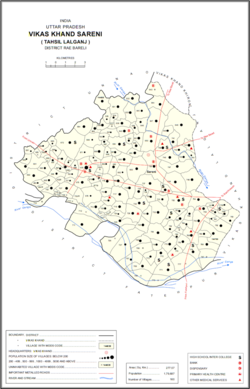Jhampur is a village in Sareni block of Rae Bareli district, Uttar Pradesh, India.[2] It is located 15 km from Lalganj, the tehsil headquarters.[3] As of 2011, it has a population of 1,126 people, in 210 households.[2] It has one primary school and no healthcare facilities, and does not host a weekly haat or a permanent market.[2] It belongs to the nyaya panchayat of Sareni.[4]
Jhampur
Jhāmpur | |
|---|---|
Village | |
 Map showing Jhampur (#748) in Sareni CD block | |
| Coordinates: 26°07′45″N 80°50′46″E / 26.129084°N 80.846193°E[1] | |
| Country | |
| State | Uttar Pradesh |
| District | Raebareli |
| Area | |
• Total | 1.977 km2 (0.763 sq mi) |
| Population (2011)[2] | |
• Total | 1,126 |
| • Density | 570/km2 (1,500/sq mi) |
| Languages | |
| • Official | Hindi |
| Time zone | UTC+5:30 (IST) |
| Vehicle registration | UP-35 |
The 1951 census recorded Jhampur as comprising 3 hamlets, with a total population of 462 people (227 male and 235 female), in 81 households and 71 physical houses.[5] The area of the village was given as 471 acres.[5] 65 residents were literate, 62 male and 3 female.[5] The village was listed as belonging to the pargana of Sareni and the thana of Sareni.[5]
The 1961 census recorded Jhampur as comprising 2 hamlets, with a total population of 477 people (226 male and 251 female), in 93 households and 85 physical houses.[6] The area of the village was given as 771 acres.[6]
The 1981 census recorded Jhampur as having a population of 725 people, in 110 households, and having an area of 195.16 hectares.[3] The main staple foods were given as wheat and barley.[3]
The 1991 census recorded Jhampur as having a total population of 774 people (370 male and 404 female), in 126 households and 126 physical houses.[4] The area of the village was listed as 192 hectares.[4] Members of the 0-6 age group numbered 115, or 15% of the total; this group was 50% male (57) and 50% female (58).[4] Members of scheduled castes made up 23% of the village's population, while no members of scheduled tribes were recorded.[4] The literacy rate of the village was 40% (208 men and 104 women).[4] 210 people were classified as main workers (177 men and 33 women), while 0 people were classified as marginal workers; the remaining 564 residents were non-workers.[4] The breakdown of main workers by employment category was as follows: 131 cultivators (i.e. people who owned or leased their own land); 4 agricultural labourers (i.e. people who worked someone else's land in return for payment); 0 workers in livestock, forestry, fishing, hunting, plantations, orchards, etc.; 0 in mining and quarrying; 0 household industry workers; 31 workers employed in other manufacturing, processing, service, and repair roles; 4 construction workers; 5 employed in trade and commerce; 6 employed in transport, storage, and communications; and 29 in other services.[4]
References
edit- ^ "Geonames Search". Do a radial search using these coordinates here.
- ^ a b c d e "Census of India 2011: Uttar Pradesh District Census Handbook - Rae Bareli, Part A (Village and Town Directory)" (PDF). Census 2011 India. pp. 262–87. Retrieved 23 October 2021.
- ^ a b c Census 1981 Uttar Pradesh: District Census Handbook Part XIII-A: Village & Town Directory, District Rae Bareli (PDF). 1982. pp. 146–7. Retrieved 23 October 2021.
- ^ a b c d e f g h Census 1991 Series-25 Uttar Pradesh Part-XII B Village & Townwise Primary Census Abstract District Census Handbook District Raebareli (PDF). 1992. pp. xxiv–xxviii, 176–7. Retrieved 23 October 2021.
- ^ a b c d Census of India, 1951: District Census Handbook Uttar Pradesh (42 - Rae Bareli District) (PDF). Allahabad. 1955. pp. 110–1. Retrieved 23 October 2021.
{{cite book}}: CS1 maint: location missing publisher (link) - ^ a b Census 1961: District Census Handbook, Uttar Pradesh (39 - Raebareli District) (PDF). Lucknow. 1965. pp. lxxiv-lxxv of section "Dalmau Tahsil". Retrieved 23 October 2021.
{{cite book}}: CS1 maint: location missing publisher (link)
